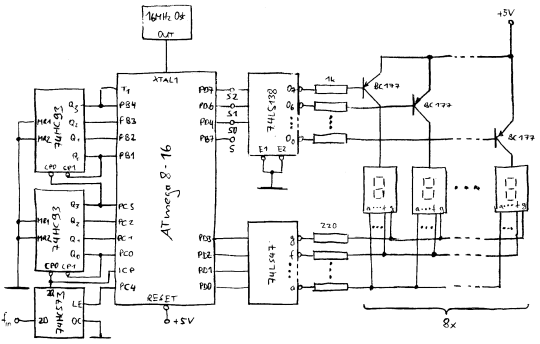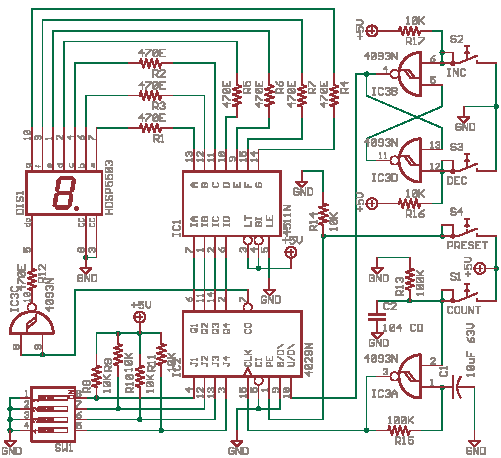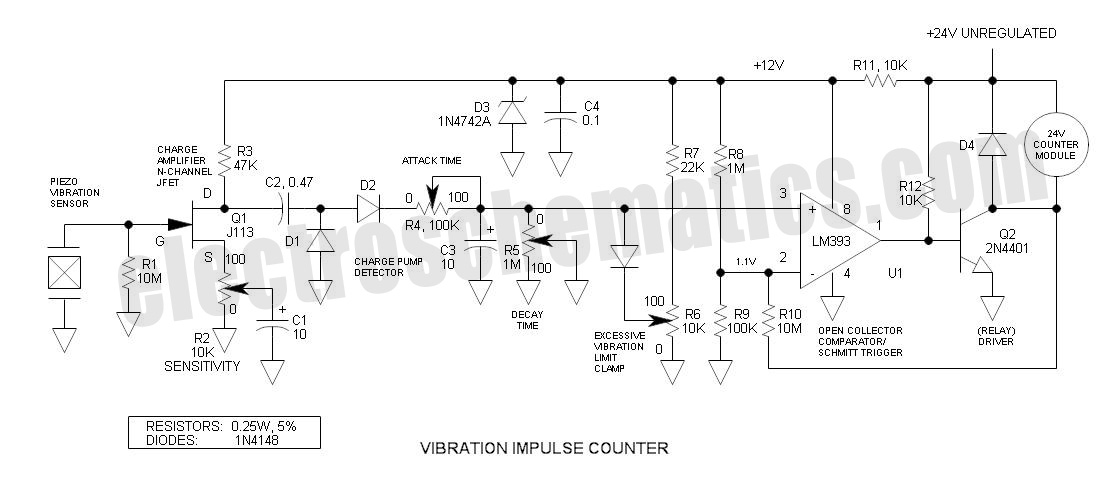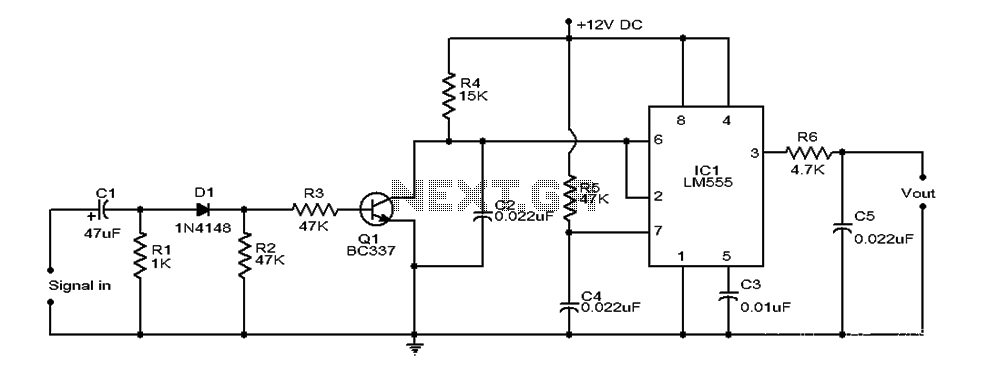
Frequency Counter and Timer

In counter mode, it provides 1 Hz resolution up to 100 MHz. In timer mode, the maximum resolution is 0.0000001 Hz up to 1 Hz. The resolution decreases by one digit for each additional decade. Multiple frequency updates per second are achieved by employing a sliding window for calculation. If the AVR should be programmable in-circuit, a few modifications must be made. Specifically, all third-party connections used for programming are isolated using 47 kΩ resistors. These resistors, in combination with the Mega8 gate capacitance, create a low-pass filter. This is compensated in software by increasing the settling time for the external counter. The accompanying image depicts the test board with the complete counter circuit, excluding the 7-segment LEDs, which are mounted and soldered on a separate board. The wires at the top right connect to this board, with one connector for digit selection and another for the actual 7-segment code. This final board will be integrated into the device, equipped with connectors for power, 7-segment code, digit selection, in-circuit programming, and TTL signal input.
The circuit described offers a versatile frequency counter and timer functionality, with a resolution that is adaptable depending on the operational mode. In counter mode, the device is capable of handling frequencies up to 100 MHz while maintaining a 1 Hz resolution, making it suitable for high-speed applications. Conversely, in timer mode, the resolution is significantly enhanced, allowing for measurements as precise as 0.0000001 Hz, albeit limited to frequencies up to 1 Hz.
The implementation of a sliding window calculation method allows the device to update its frequency readings multiple times per second, enhancing responsiveness. This feature is particularly beneficial in applications where frequency stability and quick response times are critical.
For in-circuit programmability of the AVR microcontroller, careful consideration of the circuit design is necessary. The use of 47 kΩ resistors to isolate third-party programming connections is a prudent design choice that minimizes interference and protects the integrity of the programming signals. The combination of these resistors with the Mega8 gate capacitance forms a low-pass filter that helps to stabilize the signals during programming, ensuring reliable operation.
Software compensation for settling time is employed to further enhance performance, allowing the external counter to operate effectively despite any potential delays introduced by the circuit.
The test board assembly, as depicted in the accompanying image, showcases the complete counter circuit, with the exception of the 7-segment display components, which are housed on a separate board for ease of integration. The connections for digit selection and 7-segment code transmission are clearly defined, facilitating straightforward assembly and troubleshooting.
This final board design is optimized for integration into the intended device, featuring dedicated connectors for power supply, 7-segment display code, digit selection, in-circuit programming, and TTL signal input. This comprehensive approach ensures that the circuit is both functional and adaptable, meeting the demands of various electronic applications.In counter mode it provides 1Hz resolution up to 100Mhz. In timer mode maximum resolution is 0. 0000001 Hz up to 1Hz. Resolution is reduced by one digit for each additional decade. Multiple frequency updates per second by employing a sliding window for calculation. In case the AVR should be programmable in circuit, a few modifications must be made. In essence all third parties on wires used for programming are isolated using 47k resistors. The resistors in combination with Mega8 gate capacity create a low pass. This is software compensated using increased settling time for the external counter. This picture shows the test board with the full counter circuit except the 7 segment LEDs. Those are already mounted and soldered on a separate board. The wires on the top right connect to it. (One connector for digit selection and one for the actual 7 segment code. ) This is the final board that will be put into the device. It has connectors for power, 7 segment code, digit selection, in circuit programming and TTL signal input. 🔗 External reference
The circuit described offers a versatile frequency counter and timer functionality, with a resolution that is adaptable depending on the operational mode. In counter mode, the device is capable of handling frequencies up to 100 MHz while maintaining a 1 Hz resolution, making it suitable for high-speed applications. Conversely, in timer mode, the resolution is significantly enhanced, allowing for measurements as precise as 0.0000001 Hz, albeit limited to frequencies up to 1 Hz.
The implementation of a sliding window calculation method allows the device to update its frequency readings multiple times per second, enhancing responsiveness. This feature is particularly beneficial in applications where frequency stability and quick response times are critical.
For in-circuit programmability of the AVR microcontroller, careful consideration of the circuit design is necessary. The use of 47 kΩ resistors to isolate third-party programming connections is a prudent design choice that minimizes interference and protects the integrity of the programming signals. The combination of these resistors with the Mega8 gate capacitance forms a low-pass filter that helps to stabilize the signals during programming, ensuring reliable operation.
Software compensation for settling time is employed to further enhance performance, allowing the external counter to operate effectively despite any potential delays introduced by the circuit.
The test board assembly, as depicted in the accompanying image, showcases the complete counter circuit, with the exception of the 7-segment display components, which are housed on a separate board for ease of integration. The connections for digit selection and 7-segment code transmission are clearly defined, facilitating straightforward assembly and troubleshooting.
This final board design is optimized for integration into the intended device, featuring dedicated connectors for power supply, 7-segment display code, digit selection, in-circuit programming, and TTL signal input. This comprehensive approach ensures that the circuit is both functional and adaptable, meeting the demands of various electronic applications.In counter mode it provides 1Hz resolution up to 100Mhz. In timer mode maximum resolution is 0. 0000001 Hz up to 1Hz. Resolution is reduced by one digit for each additional decade. Multiple frequency updates per second by employing a sliding window for calculation. In case the AVR should be programmable in circuit, a few modifications must be made. In essence all third parties on wires used for programming are isolated using 47k resistors. The resistors in combination with Mega8 gate capacity create a low pass. This is software compensated using increased settling time for the external counter. This picture shows the test board with the full counter circuit except the 7 segment LEDs. Those are already mounted and soldered on a separate board. The wires on the top right connect to it. (One connector for digit selection and one for the actual 7 segment code. ) This is the final board that will be put into the device. It has connectors for power, 7 segment code, digit selection, in circuit programming and TTL signal input. 🔗 External reference





